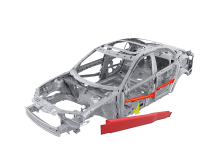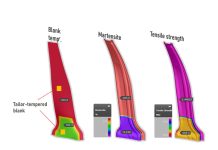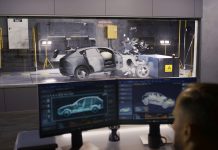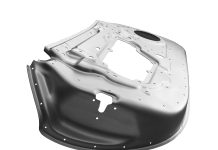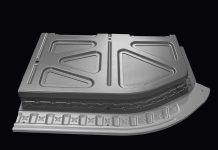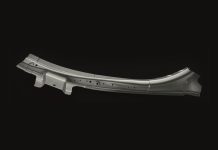A Prime Example of Developing New Hotforming Methods
Using Simulation Tools
[dropcap]A[/dropcap] unique technology named the “Smart Hot Press” or SHP has been developed by Asteer in Japan. In this blog post we provide an inside look at how they used simulation tools to develop this impressive patented technology.
To recap their achievements using this method: 1) hot press heating has been reduced from 5 Minutes to an amazing 5 seconds 2) the power cost required to produce parts has been reduced by 20%, and 3) the facility area has been reduced by a whopping 90%, seeing they were able to eliminate the need for furnaces. You can read part 1 of this three part series here.
AutoForm-ThermoSolverplus (hereafter AF-ThermoSolverplus)was used as the main tool to develop the method, and although the project started out using another brand’s software the development team switched as ‘the demand for speed increased,’ says Mr. Shimotsu, Asteer Development Manager, adding ‘by cutting down the calculation time, we can spend more time on the later validation operations.’
 Before officially introducing AF-ThermoSolverplus, Asteer conducted the benchmark calculation with its unique SHP method, including #1. partial non-quenching of the bumper beam, and #2. a new method of partial non-quenching, in order to examine if the software would suit well on site. Mr. Shimotsu says “As a result of the benchmark, we could confirm that the position of the sheet to apply the partial non-quenching could be simulated correctly with the software. Besides, we could also confirm that we could even simulate the hardness of the partial non-quenching.”
Before officially introducing AF-ThermoSolverplus, Asteer conducted the benchmark calculation with its unique SHP method, including #1. partial non-quenching of the bumper beam, and #2. a new method of partial non-quenching, in order to examine if the software would suit well on site. Mr. Shimotsu says “As a result of the benchmark, we could confirm that the position of the sheet to apply the partial non-quenching could be simulated correctly with the software. Besides, we could also confirm that we could even simulate the hardness of the partial non-quenching.”
Mr. Shimotsu added “With the partial non-quenching, usually, CAD is used to model the position for the partial non-quenching in the frame of the product geometry. And it is in the state of the flat sheet until the temperature is distributed. Therefore, with conventional software it takes time to determine which temperature is distributed on which part of the sheet, as done by going back and forth over the CAD data. With AF-ThermoSolverplus running the analysis just once, using the inflow feature, sets the position to distribute the temperature on the flat sheet in the heating process of the partial non-quenching. This is quite helpful.’
AF-ThermoSolverplus is also currently used at Asteer for tool creation for new parts upon receiving an order. Here, Asteer has become the third customer to successfully achieve the ‘one time tryout loop’ for tool creation, without modifications.

Mr. Yasuhiro Miyake from the Development and Engineering Department said ‘When working with the hot press method it is necessary to expect some shrinkage of the material due to heat exposure. Also, the conditions for the press pressure are complex. AF-ThermoSolverplus is used for a mass produced part to determine the material size, the tool structure, and forming conditions. The accuracy of the part as it was drawn, as well as the quality of the hardening, can be obtained by running a single analysis. Since the tool under the hot press method is made from rather hard steel, it is a difficult to process or modify at the later stage. Therefore it’s effective to have an accurate analysis that is run only once.“

Cut then Formed and Hardened at the Same Time?
In order to expand the SHP method using the direct resistance heating method, Asteer keeps examining the application for complex shaped parts. There are two specific targets, including the trapezoid shaped center pillar reinforcement, and the arc shaped roof rail reinforcement.
By applying the SHP method the yield rate of the material can be improved, and the laser trim can be reduced. Last year Asteer worked together with Arrk Corporation to run “the heated cut & form at a single stroke”, whereby the sheet is heated with direct resistance to 900°C, and while heated is cut then formed and hardened at the same time. And the tool was examined using AF-ThermoSolverplus.

Mr. Shimotsu explained ‘With the heated cut and form of the roof rail reinforcement for example, the issue was the layout of the cooling channel and the cylinder of the tool that would determine the pad pressure. So AF-ThermoSolverplus was used for examination, and the optimal pad pressure that holds all the cutting accuracy, quenching and the layout for the cooling channel could be determined.’
Asteer has established SHP technology with the direct resistance heating system and the partial non-quenching. From now on, Asteer, together with AF-ThermoSolverplus, will keep working on further development of new technology, as well as further expansions for the application of their hot press method for various kinds of parts.
Special thanks to AutoForm’s Japanese office for another great article for our readers.
For new readers: don’t forget that if you subscribe to our blog you’ll get post updates to your inbox once per month. We’ll never send you any marketing emails, only pure sheet metal forming news delivered to you monthly so you can stay informed on the latest hot topics.



